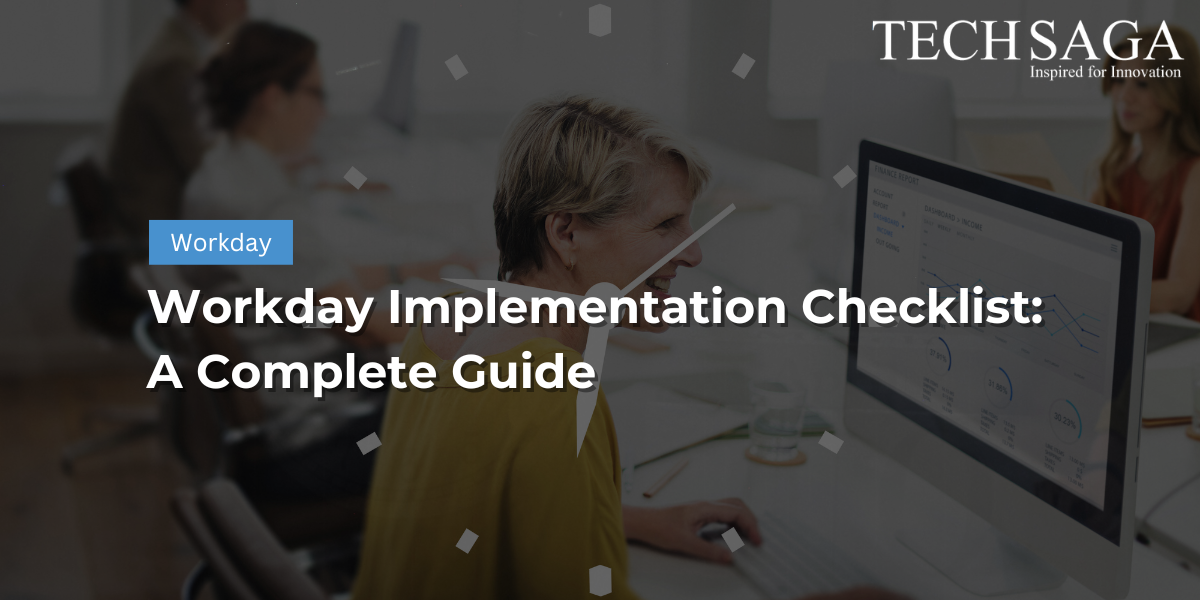Techsaga USA
Get valuable insights and stay updated on our interesting Techsaga US blog. We are experts in the world of IT consulting and IT support.
Workday Implementation Checklist: A Complete Guide
Embarking on a Workday implementation journey can be both exciting and daunting. The potential benefits of streamlined workflows, improved data visibility, and enhanced user experience are undeniable. Navigating the implementation workday process itself requires careful planning, meticulous execution, and a focus on user adoption. Balancing excitement and the inherent challenges, successful implementation hinges on strategic planning to maximize the transformative impact of Workday while minimizing disruptions to daily operations.
This comprehensive guide provides a step-by-step checklist to ensure a smooth and successful Workday implementation. Eventually, empowering you to unlock the full potential of this powerful cloud-based platform. However, we will first look into what Workday exactly is.
Workday – Definition
Workday is a cloud-based platform that helps companies manage their finances, human resources, and even student/faculty data (for universities). Think of it as a central hub for everything from payroll and benefits to performance reviews and scheduling. By streamlining workflows, providing real-time insights, and boosting user experience, Workday aims to make workdays (and every other day) more efficient and productive. However, implementing it requires careful planning and user adoption to be truly effective.
Comprehensive Guide for Workday Implementation
Phase 1: Planning and Preparation (Kickstart Your Project)
1. Define Project Scope and Objectives:
- Clearly articulate your business goals and desired outcomes for the Workday implementation. Are you aiming to improve HR processes, gain better financial insights, or consolidate multiple systems?
- Prioritise modules by impact and feasibility; commence with vital ones such as HR and Finance. Implement a phased approach for additional modules, ensuring a strategic rollout for sustained success.
2. Assemble Your Implementation Team:
- Establish a cross-functional team comprising IT, HR, Finance, and relevant departments to foster collaboration. This diverse group ensures comprehensive insights, smooth communication, and effective problem-solving throughout the Workday implementation process.
- Identify influential decision-makers, adept system administrators, and enthusiastic end-users to champion the Workday project, fostering commitment and driving successful adoption across the organisation.
3. Establish Governance Structure:
- Establish transparent roles and responsibilities for team members, designating project leads, change managers, and communication specialists to ensure a cohesive and organised Workday implementation process.
- Execute a robust communication plan to consistently update and engage stakeholders, fostering transparency and collaboration throughout the Workday implementation process for sustained project success.
4. Secure Budget and Timeline:
- Formulate a realistic project budget by accounting for software licences, implementation fees, training costs, and potential data migration expenses, ensuring financial preparedness for a successful Workday implementation.
- Establish a well-defined timeline featuring key milestones and deliverables, mindful of dependencies and potential obstacles, to ensure a structured and efficient Workday implementation with successful outcomes.
5. Data Assessment and Preparation:
- Thoroughly assess your current data landscape, identifying sources, quality concerns, and potential migration challenges, laying a foundation for effective data management during the implementation process.
- Create a meticulous data cleansing and validation plan, ensuring the accurate and consistent transfer of data to Workday, mitigating errors, and guaranteeing the integrity of the migrated information.
Phase 2: Implementation and Configuration (Building Your Workday)
1. System Configuration and Customization:
- Collaborate closely with your implementation partner to configure Workday modules aligned with your business processes and specific needs, ensuring seamless integration for optimal performance and functionality.
- Clearly define user roles, security settings, and access controls, safeguarding data integrity and ensuring compliance during the Workday implementation, fostering a secure and compliant operational environment.
2. Integration with Existing Systems:
- Identify necessary integrations to seamlessly connect Workday with critical systems such as payroll, timekeeping, or learning management platforms, fostering comprehensive and interconnected business processes.
- Establish data flows and transformation rules to facilitate smooth information exchange between systems, ensuring seamless interoperability and consistent data integrity throughout the integration process with Workday.
3. Testing and Quality Assurance:
- Conduct rigorous unit, integration, and user acceptance testing (UAT) to pinpoint and address configuration issues or bugs, ensuring a robust and error-free implementation.
- Iteratively refine user workflows and optimise system performance by incorporating feedback from user acceptance testing (UAT), ensuring a tailored and efficient Workday implementation aligned with user expectations.
Phase 3: Training and Go-Live (Empowering Your Users)
1. Develop a Comprehensive Training Program:
- Craft targeted training materials tailored to diverse user groups and their unique needs, ensuring effective knowledge transfer and seamless user adoption during the Workday implementation process.
- Utilise varied learning formats, including instructor-led sessions, online modules, and self-paced tutorials, to cater to diverse learning preferences and enhance the effectiveness of training during Workday implementation.
2. Change Management Strategy:
- Deploy a comprehensive change management plan to address user concerns, cultivate buy-in, and foster user adoption, ensuring a smooth and successful transition during the Workday implementation process.
- Establish continuous communication channels, robust support systems, and effective feedback mechanisms to facilitate a seamless transition, ensuring ongoing success and user satisfaction during the Workday implementation.
3. Go-Live and Ongoing Support:
- Execute a well-structured go-live plan to minimise disruptions and ensure a seamless system launch, incorporating strategic measures for a successful and controlled Workday-implementation.
- Provide continuous support through accessible help desks, knowledge bases, and readily available resources, ensuring users have the necessary assistance post-implementation for sustained success with Workday.
Phase 4: Optimization and Continuous Improvement (Beyond the Launch)
1. Monitor System Performance and Usage:
- Monitor and analyse key performance indicators (KPIs). To evaluate the impact of Workday on your business goals, facilitating informed decision-making and ongoing optimization for sustained success.
- Evaluate user feedback and system usage data to pinpoint areas for optimization. And leveraging insights to continuously enhance the Workday implementation for improved efficiency and user satisfaction.
2. Continuous Learning and Development:
- Promote continuous learning opportunities for users, enabling them to maximise the full potential of Workday’s capabilities. And ensuring ongoing proficiency with the system for sustained operational excellence.
- Stay informed about new features and functionalities by staying abreast of Workday’s release cycles, ensuring your organisation benefits from the latest enhancements and advancements in the platform.
3. Embrace a Culture of Continuous Improvement:
- Cultivate a culture of continuous improvement by actively seeking feedback. By identifying enhancement opportunities, and iterating on your implementation in workday, fostering ongoing refinement and excellence in operational processes.
Remember:
- Communication is key: Keep stakeholders informed throughout the process, address concerns proactively, and foster open communication channels.
- Data is your foundation: Ensure data accuracy, completeness, and consistency for a smooth transition and optimal system performance.
- Change management is crucial: Prepare users for the transition, address their concerns, and provide ongoing support to drive user adoption.
- Continuous improvement is essential: Regularly assess your implementation in workday. Identify optimization opportunities, and embrace a culture of learning and improvement.
Final Thoughts
Adhering to a comprehensive checklist and customising it to your unique requirements is pivotal for a triumphant implementation of workday. This approach guarantees the realisation of the platform’s full potential, fostering a transformative impact on business processes. Ensuring success involves strategic alignment with organisational needs, meticulous planning, and responsive adaptations. By embracing this tailored checklist, you pave the way for an efficient integration of Workday. By optimising workflows, and catapulting your business into a new era of operational excellence.
Read More: Offshore Outsourcing advantages
TAG: Techsaga USA



